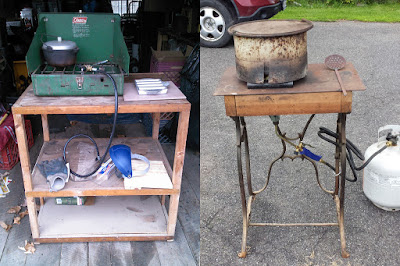Now that we have our raw materials, we can’t just melt it and start casting bullets; our lead supply contains many impurities we need to clean out first. While some people refer to this step as smelting, it’s more properly termed rendering.
Safety
Before we
go any further, I need to talk about safety. We’re
dealing with molten metal at over 700 degrees Fahrenheit, which can cause terrible burns and permanent
injury if we’re not careful. In addition, some of the gasses this process emits are not
healthy either. I shouldn’t have to say this, but this process should be done
outside in dry weather.
My
recommendations for protective gear are as follows:
- Heavy shoes, preferably leather
- Heavy cotton clothing (don’t wear synthetics, they melt)
- Heavy leather heat-resistant gloves (welding gloves work well)
- Full face shield
- Hat which will fit under the face shield
- Leather or heavy cotton canvas apron
- Respirator
One other
safety item: Do not, under any
circumstances, allow any liquid to get into the melt! When water converts from liquid to steam, it
increases in volume 1,600 times, and this
reaction can empty a twenty pound pot of lead in an instant. In the hobby, we
call this "Getting a visit from the Tinsel Fairy."
While we
make light of it with this name, it’s no laughing matter. Simple precautions, such as putting the metal
in the pot before heating to evaporate any water, making sure scrap metal
doesn’t have any closed chambers, and keeping a heavy cover on the pot during
the melt can reduce this risk and protect our delicate skin, eyes, and lungs from molten metal and
unpleasant gasses.
Equipment
Depending on the amount of casting we’re planning to do, the equipment needed can be fairly minimal. To get started, all you need are:- Propane or white gas camp stove
- Small cast iron pot
- Slotted spoon
- Ladle
- Ingot molds
Much of this equipment can be sourced from thrift shops and yard sales. For ingot molds we can use muffin tins, so long as they’re steel or cast iron. Avoid aluminum, as the lead can melt its way through with disastrous results. There are of course purpose-made ingot molds, but they’re generally more expensive.
 |
| A yard sale ingot mold. The author uses this one for pewter. |
Process
The first step involves melting the lead to a liquid state. This usually occurs between 700 and 750 degrees Fahrenheit depending on the alloy. A high temperature thermometer is useful here.
At this
point, we need to get our alloy casting clean. Remove any dirt or debris such as wheel weight clips, range dirt, and
bullet jackets. This one’s easy, as all these things are lighter than molten lead
and float to the top to be skimmed off with our slotted spoon.
Then we need to
make sure any oxidized lead on the surface is reduced back into the alloy. Some
people use a small amount of candle wax for this, but let’s wait on that.
Next is
fluxing which removes any dissolved
metals we don’t want (aluminum, cadmium, etc) while retaining
the tin, antimony, copper, silver, etc. that’s in there. According
to some researchers, one of
the best materials which can perform all these actions is good old sawdust.
Avoid sawdust made from pressure treated lumber or plywood, as it has some nasty
chemicals we don’t want.A layer of sawdust sprinkled on top of the molten
alloy, allowed to char, stirred through and then skimmed off, can result in nice,
clean, well balanced, alloy.
Once we’ve
done this once or twice, we can ladle the molten lead into our ingot molds.
Eventually, we should have a nice collection of lead alloy appropriate for
bullet casting and formed into ingots.
 |
| A batch of pewter ingots, fresh from the mold. |
I’ll go over bullet casting equipment and the casting process in a future article. In the meantime, browse the Cast Boolits online forum for more information.



No comments:
Post a Comment